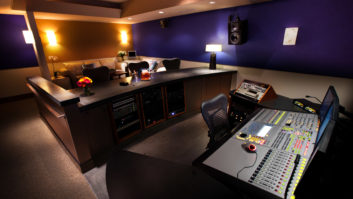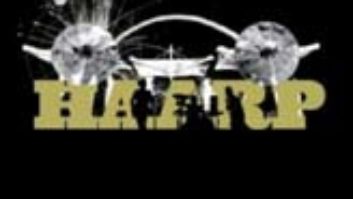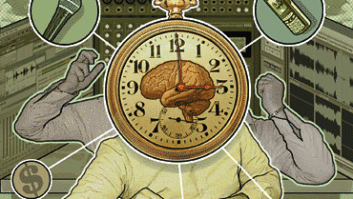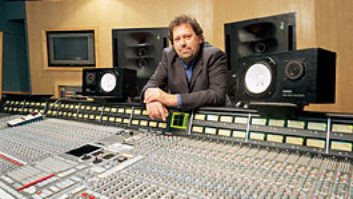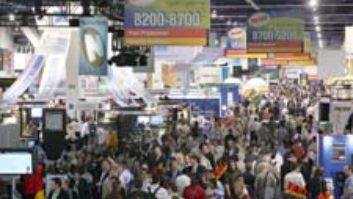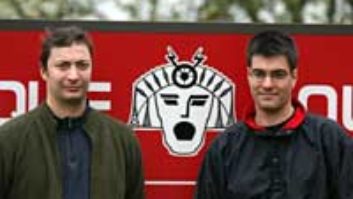Despite their relative lack of success in the United States, Oasis are still one of the biggest live acts in the world, and every UK concert is still a special — and often record-breaking — occasion. The DVD release, Familiar to Millions, captures the latest lineup of the band in full flight. A sell-out gig at Wembley Stadium in London, it was recorded by the former Manor Mobile onto a Studer 48-track DASH machine and transferred to Sony 3348 DASH at West London’s Townhouse Studios, owned by Virgin Records.
There, renowned engineer Andy Rose set about creating both stereo and 5.1 mixes for the DVD, using an SSL 8000 G Plus console with a customized 5.1 monitoring section. He mixed down to 5-channel surround and 2-track on a SADiE system, with digital metering and PORTiA video monitoring. The .1 sub channel was left, and later filtered off at the mastering stage. Rose worked closely with songwriter and guitarist Noel Gallagher, who also produced the release. “They performed 17 songs, and all 17 songs are on the DVD,” says Rose. “Nothing was overdubbed; it was amazing.” Mark “Spike” Stent did the stereo mix for the CD release.
Rose had completed about 30 surround audio mixes prior to tackling Oasis, most of them live music performances. He is a veteran of the mobile recording scene in the UK, with particular experience in live TV shows. He started his career in the music business with Mobile One at the age of 22, and just six years later in 1983, he co-founded Fleetwood Mobiles, which is still going strong as part of the Sanctuary Group of recording services in West London, although the unit is now known as one of the Sanctuary Mobiles.
“I had the multitrack tapes to myself for a couple of days before Noel came,” he says, “so I listened to them from top to tail. The only things we left out were bits of chat they didn’t want, changing guitars, the usual things.
“Noel has the final say on everything,” he continues, “although he’s not a ‘Let’s try 2 dB at 5 kHz’ kind of guy. He’s just totally into recapturing the vibe of the gig.”
Everything was recorded straight from the amps and mics to tape, with no EQ or gating. “There’s no need if you are doing a live gig,” explains Rose. “Record the band flat, and when you rewind and press Play, electronically and technically, it’s as if the band was playing again because you’ve got exactly the same parameters. Your faders, from which you are creating your mix, may be off tape, but it’s the same thing as the live performance.”
The Oasis camp very much liked the mix from the TV and radio broadcast of the concert. This was courtesy of mobile engineer Jon Lemon, an old friend of Rose’s and the guy who provided the flat, multitrack recording. “So we aimed in that direction, but with surround,” Rose says.
Each microphone was split away completely from the P.A. Once into the main active splitter, the signal to the mobile could not affect the P.A. sound, and the P.A. could not change the mobile sound. Isolated electronically, neither got in the other’s way.
For 5.1, the guitars and bass were immediately spread wider than the front stereo mix, with the main bass right in the middle giving a strong focus. Both Rose and Gallagher were keen that the whole thing be like an “extended” stereo mix, “and if we put a bit of fairy dust behind it, then that was fine,” adds Rose. To that end, Rose decided to do both mixes together so that one didn’t drift away from the other.
“The main difference is the rear audience, which I obviously didn’t have on the stereo mix. I also had a delayed reverb — like a quadraphonic reverb — to give a sense of space. I changed the time of the rear audience as well, bringing it forward to avoid the slap-black of the drums, which aren’t in time because of the delay towers. So there is time adjustment, but you still get this feeling of a big open sound at the back.
“Although the feel of the stereo mix was the main thing, you still have to respect the DVD format,” he continues. “If someone has gone out and tripled their expenditure on a surround room, they’ll want to get something out of it. DVD has got to do something to give you a real sense of something being around you, and a live gig is the perfect way. It gives you the opportunity to put this rear ambience behind you.”
Because the tape was recorded flat, a lot of EQ was added at the mix stage, from both Massenburg and Avalon units. The only things gated were the tom-toms, “because they just sit there humming away,” says Rose. However, the drums are laid out three times: the straight drum track, one heavily gated, and another heavily EQ’d. “I just fade in the effect, rather than have a gated snare,” Rose explains. “So you have an open snare, to add just the right amount of cut. It’s the same with the bass drum: I take a feed of it and seriously gate it, and seriously EQ it, and just add the taste. It’s not all gated, or all EQ’d. You’ve got a bit of the air there, but not so much that it becomes intrusive. We also spent quite a bit of time working on an overall compression of the stereo drum group, just to give it a nice fat feel. We used the Chiswick Reach stereo model.”
The only ingredients mixed with the bass in the center channel are heavily compressed drums and lead vocal — with no reverb. “You can hear the audience all the time, which creates the air,” says Rose. “If you’ve only got a stereo track of audience, you can’t create a good surround mix. It’s no good trying to create a stereo sound out of a mono source — it will always sound poor. It’s the same with trying to make quad, or 5.1, out of stereo.
“Sure, a lot of people do that. You can stick it into a Lexicon and take the two stereo channels out and make one a bit duller, one a bit longer, one a bit later and so on. You develop a spectrum, so that it’s not the same reverb or signal at the front as at the back. It can make it appear that there is something going on. But there’s this whole thing with desk manufacturers, where they assume that when you pan hard left you only want the signal in the left-hand speaker. When you pan in the center, therefore, it is just in the middle speaker, which sounds crap. One speaker doesn’t sound nearly as good as monitoring from two.
“You can only get a blend using the divergence knob,” Rose continues. “You can decide how much hard left is actually in which speaker, which is fine. But what you can’t do is take the snare drum and have it coming out of the left and right, like I’m used to. This seems to be the case with all the desks I’ve tried, including SSL and Soundtracks. I’ve not tried Euphonix, though.
“We like that thing of sound — like a bass drum — coming from two speakers but actually it appears to come from the middle. So what I have to do is get a series of stereo fields, and a quad group if I want it, and then send an aux to the center speaker. If you listen to the Oasis stuff, you’ll hear that it’s just bass, drums and voice in the center.”
Oasis are a rock ‘n’ roll band, and it has to come across as such. No cleaning up, no re-performances or any of that nonsense. Get the balance and keep it exciting.
— Spike Stent
Rose also exploited the band’s habit of using several amps on each guitar to gather a wide variety of sources from each signal. “Because they were always using more than one amp, there was a chance to split each guitar, just to get a bigger source. When I do recordings myself, I always double-mic guitars, which is always an endless pain to all the P.A. guys who know me. I like to put up something that is completely different from whatever they use, to capture a different division of sound. So if they’re using, say, a big fat Audio-Technica condenser mic, I like to show up with a dynamic. If they’re using an SM57, I will stick in an U87, or something completely different.”
Rose worked to a master DigiBeta of the finished pictures, offloaded into the PORTiA module of his SADiE system. Sync and time adjustments were therefore easy, and five tracks from the original 48 were forwarded to the mastering stage.
“I don’t do it on six, I always use five. I don’t do the .1. If you do a full-frequency mix, with all the bottom end you want for the full-range speakers, you don’t need to. The .1 is made up in the process. All you have to do is filter off all the bottom end at the manufacturing stage and feed it into the spare channel.”
Meanwhile, working at his own dedicated mix room at The Townhouse’s sister facility Olympic in southwest London, Mark Stent was commissioned to prepare the traditional stereo mix for CD release. Accordingly, he concentrated on a few basic values.
“Oasis are a rock ‘n’ roll band, and it has to come across as such,” he states. “No cleaning up, no re-performances or any of that nonsense. Get the balance and keep it exciting. Sure, I compress the shit out of it! Lots of different compression, loads of EQ. Sometimes, sonically, you have to bring it up to a certain level; try to make it sound as powerful as possible. It’s not one single ingredient: Take any element out and it would fall apart.
“I use the crowd quite a lot, pushing it for certain sections. I wasn’t doing it to picture, but you get a sense in your head of what it was really like. Say, if the crowd is singing along in a chorus, I’ll push that up. Seventy thousand people singing along is exciting.
“The only problem is the delay from all around the stadium, so you have to bring that back into time. Audience mics at the back of Wembley have a big delay from the stage — there was a big slap on the drums. You just have to bring it forward in time. Sometimes a slight delay can be nice, like on vocals. But it can be annoying.”
Stent has clear views on the role, and perhaps the restrictions, of 5.1 surround in the current entertainment marketplace.
“I think 5.1 is great. The last one I did was Dancing in the Dark, the film soundtrack with Björk. I did it in 5.1, then stereo, then I had to bring the 5.1 mix down to Nicam stereo. I did it three times.
“It really depends on what type of music it is. There are gimmicks to be avoided, like panning things around a lot. For things like live gigs and movie soundtracks, 5.1 is perfect — the atmospheric stuff. Standard pop records don’t lend themselves to 5.1, but you can create an atmosphere and make people feel like they were at the gig.
“You can do that in stereo as well — just ride the crowd and make it really exciting. In the past, people have cleaned things up too much — replacing tracks and so on. Then you lose the spirit.”
“The whole DVD thing is still a learning curve,” concludes Andy Rose modestly. “It’s not acceptable to give people just a stereo mix; they may feel ripped off — even though I’m sure that most people with DVD have not got the 5.1 system. But that will change, because it is a great experience.”
